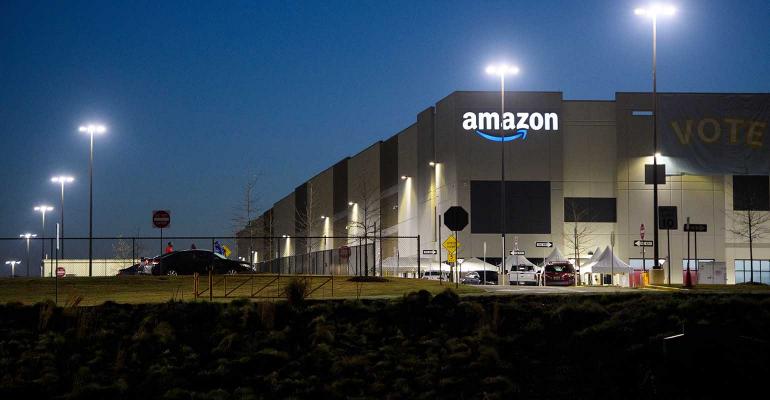Over the last decade, first-mile warehouses have evolved from traditional, 31-ft.-clear-height facilities with 500,000 to 1 million square feet into 60-foot clear-height, automated, artificial intelligence-managed behemoths of well over 3 million sq. ft. spread over three mezzanine levels.
These larger, modern facilities have become the preferred choice by Fortune 500 e-commerce retailers, from Amazon and Walmart to Best Buy and Target. The larger, tech-enabled facilities have helped mitigate labor shortages and allowed retailers to stock sufficient inventory to meet surging online customer demand, especially in a world of supply-chain uncertainties and varying delivery times.
Amazon had been especially aggressive in leasing, buying and developing warehouse space to bolster its portfolio. But then the company surprisingly announced it had too much space, and would sublet up to 30 million sq. ft. of warehouse space or renegotiate leases.
That’s raised questions about whether overall demand for industrial space may finally be cooling. But a closer look at Amazon’s plans show that it is largely looking to shed traditional, mid-market warehouses. It’s a case where they’ve upgraded to newer, better facilities and are now freeing up older stock.
And they may not be the only company looking to do that. Other Fortune 500 retailers are looking at subletting traditional warehouses they committed to long-term, because they are not in close enough proximity to customers to be used for last-mile distribution and no longer meet the needs for first-mile use, explains Kris Bjorson, international director of Industrial Brokerage at JLL. He notes that these warehouses, which were originally designed for first-mile use, are now considered mid-market because cities grew around them so they are stuck in the middle between first- and last-mile use.
Bjorson adds that any return of warehouse space to the market is a positive, especially in markets with low or no vacancy.
And even the amount of space Amazon is talking about subletting in markets like California, New Jersey and New York, where the retail giant expanded during shop-at-home peak periods amid the pandemic, will have little impact on overall market vacancy rates, notes Matt Dolly, research director for Transwestern’s Strategic Accounts Program and Industrial Real Estate.
Even at the high end, Dolly points out, 30 million sq. ft. represents less than one-quarter of one percent of the U.S. industrial real estate inventory.
“That said, it does put the market on alert, “he adds, noting that e-commerce sales velocity slowed as the country opened up. Dolly says, however, that sales are still well above pre-pandemic levels, so any regression will likely remain above previous averages.
He notes, however, that some major retailers that underestimated supply costs may eventually dial back space occupied.
“An increase in the amount of durable goods and household purchases were made during the pandemic, but now consumers are likely to revert to a more normal pace of purchasing, especially during an extended period of high inflation,” Dolly explains. “If consumer demand dips, there could be an increase in vacant space once the goods that piled up are sold and restocking is no longer necessary.”
Demand for industrial space is still outstripping supply, so Bjorson doesn’t think that even if all Fortune 500 retailers return space to the market that it would impact the supply-demand imbalance or move vacancy rates much this year. He concedes that e-commerce sales are flat and inflation remains at a high annual rate, so vacancy could become a more relevant issue in 2023.
Dolly agrees, noting that many retailers are adding space for storage purposes as they stock up on goods in anticipation of continued supply-chain challenges. Logistics/transportation companies also continue to expand, he adds.
Dolly also notes that sublet space also will offer discounted rent opportunities in certain industrial pockets, but market players are still forecasting double-digit rent growth for the next year or so, especially for new construction.
Bjorson expects rent discounts to be in the 10- to 30-percent range, depending on the sublet term. He notes that sublets will benefit smaller e-commerce retailers and startups or be converted to other uses, such as manufacturing or product assembly. Bjorson says that tenants subletting space can afford to offer generous discounts because they had originally leased the facilities some years ago at lower rents and want this obligation off their books.
Neither of these experts believe that sublet space or a little market softening will impact new construction due to “flight to quality.” Bjorson notes that Fortune 500 retailers are exiting these older warehouses to move to state-of-the art, automated facilities.
“There is still plenty of demand in the pipeline, and users and investors continue to desire modern warehouse space, putting older inventory at higher risk,” adds Dolly. He notes that industrial development also is needed where recent population shifts have occurred, as e-commerce will continue to grow—albeit not at a pandemic-driven pace.
The U.S. industrial market experienced 50 consecutive quarters of positive net absorption through the first quarter of 2022, and over the past few years, industrial real estate leasing velocity occurred at a pace never seen before, Dolly continues. As a result, many projects under development are already pre-leased, which means solid absorption numbers over the next few quarters, he adds.
Dolly notes that Amazon represents +/- 5 percent of total U.S. logistics inventory and, at one point during the pandemic, accounted for more than half of all logistics real estate growth. “So for the first time in more than a decade, industrial market players, in some cases may have to proceed with caution.”
“Amazon’s real estate decisions, as always, are worth paying attention to as market momentum can change quickly,” Dolly suggests. “In weather terms, the Amazon news is more of a ‘watch’ and less of a ‘warning’ at this time.”





